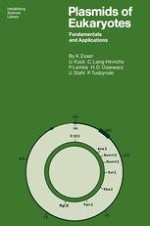1986 | OriginalPaper | Buchkapitel
Fundamental Aspects
verfasst von : Prof. Dr. Dr. h.c. Karl Esser, Dr. Ulrich Kück, Dr. Christine Lang-Hinrichs, Prof. Dr. Paul Lemke, Dr. Heinz Dieter Osiewacz, Prof. Dr. Ulf Stahl, Priv. Doz. Dr. Paul Tudzynski
Erschienen in: Plasmids of Eukaryotes
Verlag: Springer Berlin Heidelberg
Enthalten in: Professional Book Archive
Aktivieren Sie unsere intelligente Suche, um passende Fachinhalte oder Patente zu finden.
Wählen Sie Textabschnitte aus um mit Künstlicher Intelligenz passenden Patente zu finden. powered by
Markieren Sie Textabschnitte, um KI-gestützt weitere passende Inhalte zu finden. powered by
The first plasmid detected in a eukaryote was found in a strain of baker’s yeast, Saccharomyces cerevisiae almost two decades ago (Sinclair et al. 1967). Its existence was revealed initially by electron microscopic analyses, a major screening technique for extrachromosomal genetic traits in those days. Based on contour length measurements from electron micrographs, this plasmid was termed “2 μm DNA”. Further details of this initially recognized eukaryotic plasmid will be discussed in the next chapter (p. 13). However, the following biological properties of the 2 μm plasmid are particularly noteworthy: 1.Almost without exception, every strain of S. cerevisiae and closely related yeasts contain the 2 μm plasmid. Strains investigated include wild strains isolated from nature as well as laboratory and industrial strains (see Table l).2.The 2 μm plasmid is a multicopy plasmid located within the nuclear membrane and is now considered to be a “minichromosome” (p. 14).3.Unlike the prokaryotic plasmids first discovered, specific functions cannot be attributed to the 2 μm plasmid. Like many of the eukaryotic plasmids, it seems to be cryptic.4.The 2 μm plasmid has been used to develop the first eukaryotic transformation system (p.65ff.)
